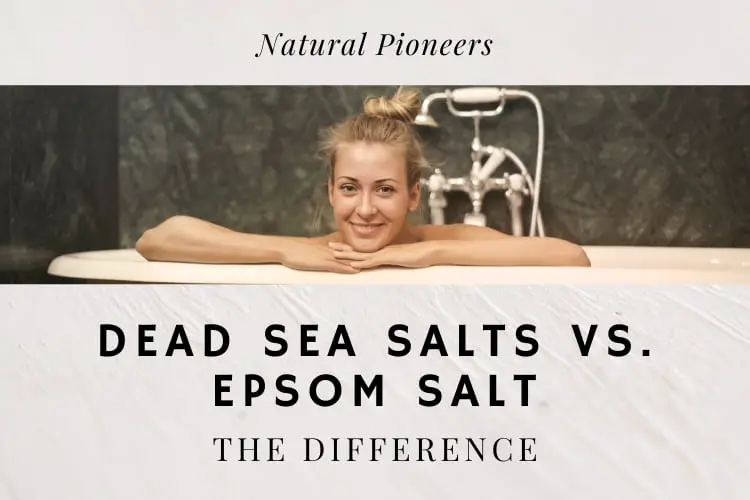
Dead Sea salt or Epsom salt, which is the better bath salt? Turns out it’s a crucial question especially athletes should ask. Surprisingly, only one of them provides science-backed benefits.
Dead Sea salt & mud are beneficial when treating skin diseases like acne, psoriasis, redness, dry skin, and signs of aging. Dead Sea salts also help with arthritis. While Dead Sea salt and Epsom salt have magnesium as a mineral in common, studies found no evidence for health benefits of Epsom salt.
Let’s look at both salts individually, and then make a conclusion.
1. Dead Sea Salts
The Dead Sea is a salt lake and the biggest natural saline reserve in the world. When we hear the word salt, most of us associate it with table salt – the seasoning. In Dead Sea salts we’re talking about a complex mineral composition that is much more than just salt.
While the Dead Sea is much saltier than ocean water, the extracted salts are less salty than table salt. Table salt consists of about 98% sodium, while Dead Sea salts contain only about 8% sodium. 60% of Dead Sea salts are magnesium and potassium.
Dead Sea Salts are made up of about 60% magnesium and potassium, 8% sodium and some rare minerals.
Another misconception is that Dead Sea salts can be used as seasoning. While a small percentage of extracted Dead Sea salts are washed and processed to edible salt, the majority is not.
Regular Dead Sea salts are not safe for consumption and taste quite bitter.
Unlike Himalayan salt, Dead Sea salts are mainly used for topical treatments. Only a very small percentage of Dead Sea minerals are processed to edible salt.
Curious about the difference between Dead Sea Salts and Epsom Salts? Dead Sea Salts Vs. Himalayan Salt | 7 Surprising Differences
In the medical field, topical treatments with Dead Sea salts and mud have shown to help with arthritis.
Their main use in cosmetic products, is to help with skin problems like stretch marks, acne, eczema, blemished skin, and aging signs. They can even cure eczema. And there are many studies that prove that Dead Sea salts and mud work for those conditions! [1]; [2]
With the shift towards more natural products, it’s no wonder that the global Dead Sea cosmetics market is booming and valued at a whooping USD 1.1 billion in 2018. [3]
Are Dead Sea minerals safe? Studies show that Dead Sea treatments have a good safety profile. The laboratory analysis of Dead Sea minerals reveals no mineral concentrations that could represent a health concern for their intended use. [4]
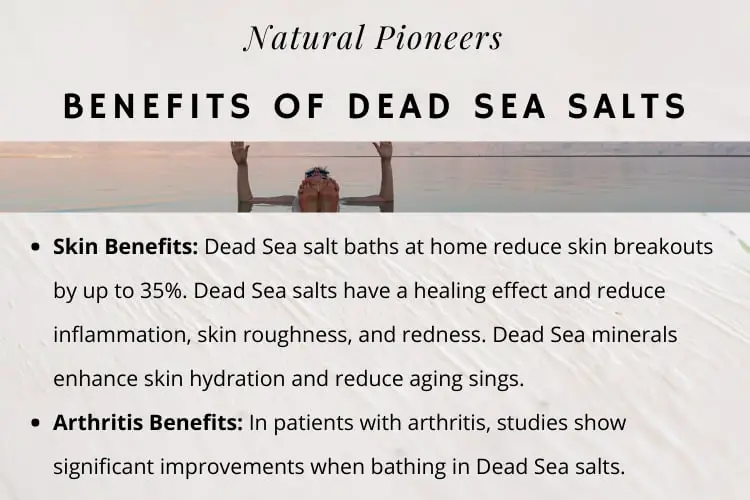
The main benefits of sea salt are seen were seen in studies that used 100% Dead Sea mud or Dead Sea salts. They were used as mud packages, masks and Dead Sea salt baths.
Dead Sea salts can help us in various ways:
- Dead Sea salt baths at home reduce skin breakouts by up to 35%. Dead Sea salts have a healing effect and reduce inflammation, skin roughness, and redness. [5]; [6]; [7]
- Dead Sea mineral baths restore moisture and enhance skin hydration. Dead Sea minerals contain a natural moisturizing factor that can improve the look of acne damaged skin. [8]
- Dead Sea baths reduce aging sings on human skin. Dead Sea minerals have a rejuvenating effect on your skin. [9]
- In rheumatoid arthritis patients, Dead Sea mud packs significantly improve morning stiffness, hand-grip strength and activities of daily living. [10]
- Dead Sea mud packs reduce pain severity in patients with chronic low back pain. [11]
- Dead Sea mud accelerates the wound healing process. [12]
- In patients with rheumatoid arthritis, daily baths in Dead Sea salts significantly improve morning stiffness, fifteen-meter walk time, hand-grip strength and circumference of joints. [13]
- Studies show Dead Sea spa therapy modalities help with psoriasis and psoriatic arthritis. [14]
- In patients with knee osteoarthritis, balneotherapy helps with pain, physical function and walking speed. [15]
Up for a trip to the Middle East?
- Baths in the Dead Sea help with Fibromyalgia. Studies show a relief of symptoms (pain, fatigue, stiffness, and anxiety) and reduced frequency of symptoms (headache, sleep problems, and subjective joint swelling). [16]
- Intermittent balneotherapy in the Dead Sea helps with knee osteoarthritis. Results lasted up to 6 months. [17]
Curious about the effects of Dead Sea mud for blemished skin? Read more: Is Dead Sea Mud Good For Acne?
Make sure you use 100% Dead Sea salts with no added ingredients to achieve the same effects as seen in studies.
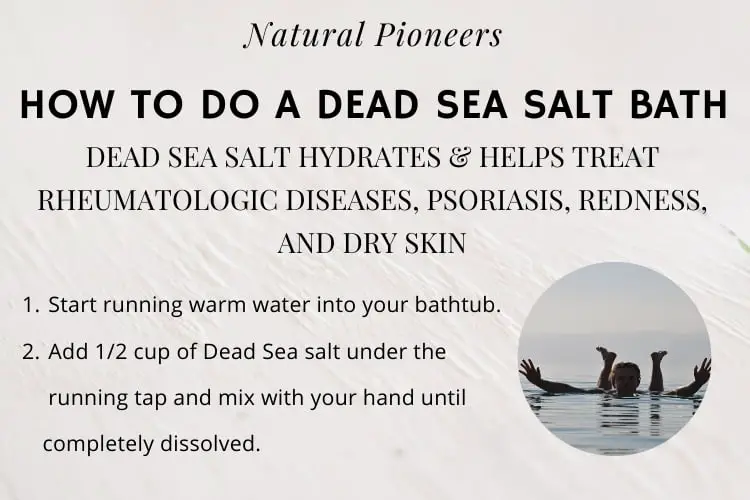
How To Do A Dead Sea Salt Bath:
- Start running warm water into a clean bathtub. Be sure it’s not too hot as hot water can aggravate inflamed skin and draw moisture from your skin.
- Add 1/2 cup of Dead Sea salts under the running tap and mix with your hand until completely dissolved. Dead Sea salts will leave a mud film on the tub – it wipes off easily.
- Enjoy!
Conclusion: Dead Sea salts are not safe for consumption and are mainly used for medical purposes to treat diseases. Dead Sea salt baths and mud prove to be beneficial to help with skin diseases like acne, psoriasis, redness, dry skin, and signs of aging. Dead Sea salts also help when treating arthritis. Dead Sea salts are considered safe according to laboratory analyses.
2. Epsom Salt
Epsom salt is also called magnesium sulfate. It’s made up of magnesium, sulfur, and oxygen. It gets its name from the town Epsom in England, where it was originally discovered.
I’ve personally used Epsom salts for a long time. Throughout my athletic career and later in addition to running & pilates. Whereas I could never say that the salt made a noticeable difference, I certainly believed so, because – well, it’s just something everyone knows.
When our team at Natural Pioneers researched the scientific database, we were frozen in shock. None, not one single study done on Epsom salts can find scientific evidence for all its imposed health benefits.
For those of you who are unfamiliar with Epsom salts, here’s the idea behind it:
Epsom salt has been traditionally used as a component of bath salts. When Epsom salt is dissolved in water, it releases magnesium and sulfate ions. These particles are supposedly absorbed through our skin, providing our bodies magnesium and sulfates. [18]
Athletes use it to soothe sore muscles, and many people swear by an Epsom salt bath in order to wind down after a busy day.
While the benefits of orally taken magnesium have long been studied (Benefits Of Water High In Magnesium), we still lack evidence for magnesium to be absorbed through our skin. [19]; [20]
Especially after having researched the topic of Dead Sea salts for months, we were confused. Why can Dead Sea salts, which consist of about 30% magnesium chloride, be so beneficial, and Epsom salt aka magnesium sulfate not show any benefits in studies?
We don’t have an answer. But we hope science can give us more information on that very soon. At this point in time, all we know is that for Epsom salt, studies cannot find evidence for or bodies to absorb magnesium through skin. Perhaps it’s the magnesium chloride or other ingredients in Dead Sea salts that make the difference.
Could we use sea salt instead of Epsom salt? According to studies, sea salt shows proven health benefits when used in hot baths. While Dead Sea salts are superior, regular sea salt should be preferred over Epsom salt. [21]
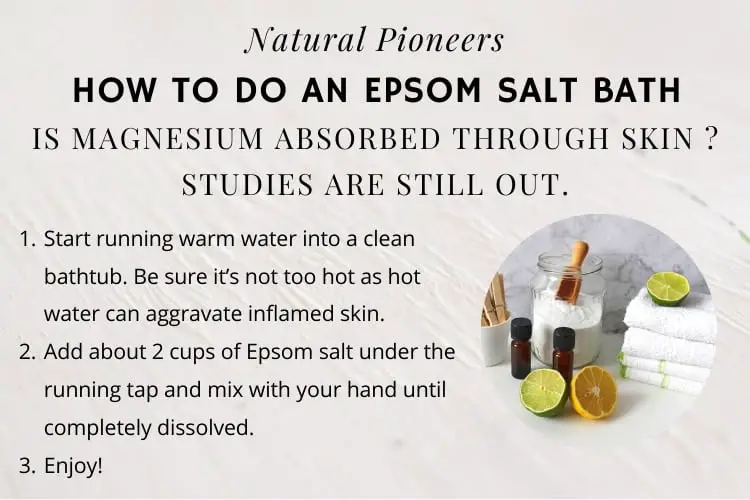
How To Do An Epsom Salt Bath:
- Start running warm water into a clean bathtub. Be sure it’s not too hot as hot water can aggravate inflamed skin and draw moisture from your skin.
- Add about 2 cups of Epsom salt under the running tap and mix with your hand until completely dissolved.
- Enjoy!
Conclusion: Based on current studies, there is no evidence for magnesium to be absorbed through human skin. Epsom salt doesn’t seem to provide more health benefits than hot baths alone. We cannot recommend Epsom salts as a bath additive.
3. Conclusion
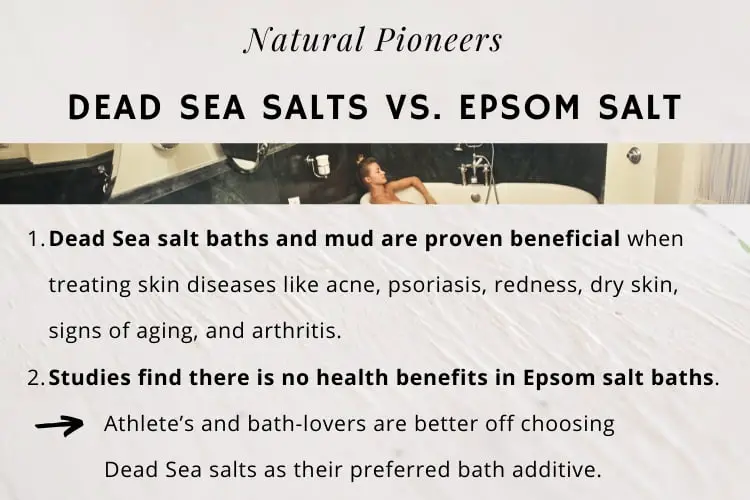
Dead Sea Salts are made up of about 60% magnesium and potassium, 8% sodium and some rare minerals. Dead Sea salts are not safe for consumption and are mainly used for medical purposes to treat diseases.
Dead Sea salt baths and mud prove to be beneficial to help with skin diseases like acne, psoriasis, redness, dry skin, and signs of aging. Dead Sea salts also help when treating arthritis.
While Epsom salt consists of magnesium as well – more precisely magnesium sulfate – studies fail to measure any absorption through skin.
According to the scientific research to this date, baths in Dead Sea salts show proven benefits whereas Epsom salts don’t. Athletes and bath-lovers are better off choosing Dead Sea salts as their preferred bath additive.
Consequently, in addition to oral magnesium supplements, which have long been studied, Dead Sea salts should be the go-to option when choosing a natural, proven, and beneficial bath additive.
Benefits of Dead Sea salt baths at home:
- Dead Sea salt baths at home reduce skin breakouts by up to 35%. Dead Sea salts have a healing effect and reduce inflammation, skin roughness, and redness. [22]; [23]; [24]
- Dead Sea mineral baths restore moisture and enhance skin hydration. Dead Sea minerals contain a natural moisturizing factor that can improve the look of acne damaged skin. [25]
- Dead Sea baths reduce aging sings on human skin. Dead Sea minerals have a rejuvenating effect on your skin. [26]
- In rheumatoid arthritis patients, Dead Sea mud packs significantly improve morning stiffness, hand-grip strength and activities of daily living. [27]
- Dead Sea mud packs reduce pain severity in patients with chronic low back pain. [28]
- Dead Sea mud accelerates the wound healing process. [29]
- In patients with rheumatoid arthritis, daily baths in Dead Sea salts significantly improve morning stiffness, fifteen-meter walk time, hand-grip strength and circumference of joints. [30]
- Studies show Dead Sea spa therapy modalities help with psoriasis and psoriatic arthritis. [31]
- In patients with knee osteoarthritis, balneotherapy helps with pain, physical function and walking speed. [32]

